The Hogs got back in the win column with an almost-perfect offensive performance in a 52-35 win over BYU.
Grading the Hogs
We assign grades based on how the team’s performance – adjusted for quality of opponent – compares to all other teams in all other games this season. The grades are 0-100 and can be thought of as percentile performances, so a grade of 65, for example, means your overall performance was better than 65% of all other performances this season.
Here are the team grades for Arkansas against BYU:
- Offense: 98
- Defense: 38
- Overall: 83
This game marked Arkansas’ best performance of the season and broke an all-season trend of each game being worse than the last. That’s a perfect “get right game”.
Advanced Stats
Confused by any of the advanced stats you see here? Be sure to check out the glossary.

It was an ideal game for the Hogs, who remained efficient as usual but also added in some big plays, which helped actually convert those drives into points. The Hogs gained a staggering 82% of available yards, which means the Hogs left only about 150 yards on the table.
Defensively, the numbers don’t look as bad as they probably looked on the TV. The Hogs gave up a ton of yards (70%) and allowed BYU to be pretty efficient (49%), but the Hogs capped explosive plays and forced turnovers. That’s not a bad formula.

Arkansas’ third-down clutchness was truly incredible, and the defense keeping BYU from getting big plays on early downs was one of our Keys to the Game, so let’s give the D some credit here, because they did an amazing job at that part.
The Hogs came out throwing (season-low 58% run rate on standard downs) and the Cougars just couldn’t stop it. We’ve beat this drum before – the Hogs were top-5 in the country last season in EPA+/Pass on standard downs and are 8th today – and the Razorbacks finally made a dedicated effort to throw the ball on early downs.
Why did Arkansas throw so much?
We discussed in the preview that BYU’s run defense is extremely soft, so why did the Hogs throw the ball 40 times? Part of it seems to be Sam Pittman’s claim after the game that he asked Kendal Briles to “open up” the offense. But that sounds a bit odd on its face: Briles comes from a wide-open system (Baylor) while Pittman has historically coached lines for ground-and-pound offenses. “Pittman tells Briles to open things up” sounds a bit like “Chamberlain warns Churchill that the Germans might be up to no good”. It’s the opposite of what you’d expect.
My hunch is that the ground-and-pound approach we’ve seen this year was probably at Pittman’s request, out of a desire to control the game. So Pittman telling Briles to open things up was more like giving Briles permission to open things up. Maybe not. It’s just odd to me that Art Briles’ son has to be told to open things up by an old-school offensive line coach.
The main change we saw Saturday came in the run game. Arkansas’ offense includes two types of run: zone runs and gap runs. For a primer on the difference, refer to this post:
The difference between this play and a normal inside zone (that the Hogs called 19 times against South Carolina) is how it is blocked. In zone schemes, the offensive linemen are responsible for blocking an area (or “zone”) and will move into the second level if there is no defender in their zone. You can often identify zone blocking when you see all five linemen move in the same direction at the snap.
In a gap scheme, linemen will use leverage and “down block” any defender that’s covering them. Gap runs are simple for offensive linemen to execute, but require patience by the ballcarrier to work properly. They are also vulnerable to unique defensive fronts, as every gap run looks different depending on how the defense aligns. Zone runs are simpler and more predictable, but they require good vision by the back, as there are often cutback lanes available.
Zone runs are a feature of the West Coast offense that Kendal Briles learned from Lane Kiffin. Gap runs are closer to what Briles used at Baylor.
To this point in the season, the Hogs have been very heavy on zone runs: entering the BYU game, about 70% run plays were zones and about 20% were gap (the other 10% were “other” runs, including draws, sneaks, and end arounds). The goal of the zone scheme is to maximize efficiency while creating big plays through cutback lanes when the backside defender overpursues. But the explosive runs haven’t come this season, and much of Arkansas’ efficiency has been wasted due to a lack of big plays.
Against BYU, I saw almost no zone runs. I think there were a few inside zones attached to RPOs, but that was about it. Instead, the Hogs repeatedly pounded the Cougars with Counter:
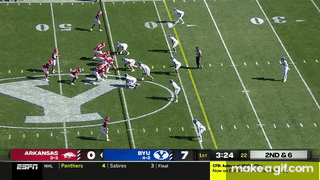
The final 64-yard touchdown run by Sanders also came on Counter. I saw at least four Counters in my rewatch, and I think there were a couple more.
BYU’s strategy also influenced the Hogs. Simply put, BYU decided that it didn’t want Rocket Sanders beating them. The Cougars opted to crash every read play to try and force Jefferson to keep the ball, either to make him run (called runs) or throw the quick outlet (RPOs). Here’s the second play of the game. Watch the unblocked read defender crash and force Jefferson to keep:
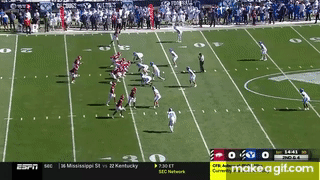
There’s been one constant over the last two season of Jefferson at quarterback: the more Jefferson runs with the ball, the worse it is for Arkansas’ offense. Opponents would much rather Jefferson run than Sanders.
Because BYU was so anxious to crash inside and force Jefferson to run, the Hogs had a ton of success by using play action to remove the stacked box from an edge pass (note the playside linebacker executing a scrape exchange):
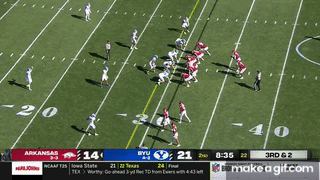
The Hogs turned BYU’s aggressiveness against them in the run game, too. Here, the Hogs call “iso” – a gap run that was the base Baylor run play under Briles. The crashing end was expecting to be unblocked or have a zone block; instead, Luke Jones turns inside and allows the end himself right out of the C-gap immediately:
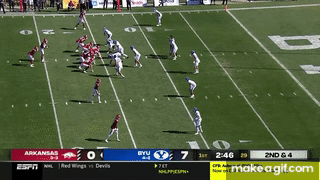
Look at Jefferson celebrating as soon as he hands off.
We saw excellent creativity in the dropback passing game as well. One of the key plays in the game came in the third quarter. BYU had just pulled within 38-35, and now the Hogs were in danger of a three-and-out, facing 3rd-and-10. The Hogs dial up this:

Ketron Jackson motions across the formation into trips and then runs a deep cross underneath a double post from Matt Landers and Jadon Haselwood. Haselwood’s route causes his defender and Jackson’s defender to collide, leaving Jackson wide open:
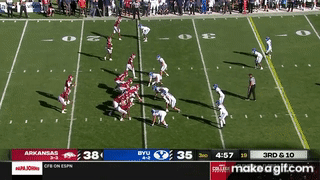
The final bit of creativity was the wheel route. I mean, the Hogs played a Bobby Petrino team earlier this year, so maybe they borrowed this one? The Hogs have actually tried to run this a couple times this year, but BYU was the first opponent who couldn’t cover it. The Hogs hit it three times, none bigger than this one:
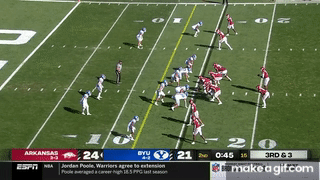
This gif is a nice segue into what made all of this possible: protection. Note that BYU is bringing a Cover 0 blitz and they don’t even get a pressure. For the most part, KJ had time to do his taxes in the pocket. The one protection bust led to the best play of the game:
That’s the issue that will make this performance hard to replicate. BYU’s defensive line is vastly inferior to every SEC team except maybe Vanderbilt. The Cougars were shockingly undersized and their bigger linebackers just were not very fast. The Razorback offensive line absolutely manhandled them in every facet of this game.
But moving forward, I do think we’ll see more gap runs and more early-down passing. The low-margin zone run game was making it hard for the Hogs to finish drives, stretch the defense vertically, or get into any kind of rhythm. What the Hogs did against BYU gives them a better opportunity to create big plays and showcase their depth at receiver. And as we saw, it really does not sacrifice Rocket Sanders’ influence in the offense. I wrote on Sunday about Arkansas’ “fleet-in-being” run game, where the threat of Arkansas running the ball is more valuable to Briles than actually running it, because it sets up so much of the offense.

Jefferson was ultra-efficient, and the run game was explosive for the first time all season. That’s what we want to see.
For BYU, again, the Cougars just couldn’t get enough big plays. They threw the ball well, but outside of a handful of efficient runs, their run game was useless to them. The Hogs switched back to the Dime defense to take away big plays and hoped BYU would make some mistakes, and they did exactly that. The Cougars failed on two fourth downs and threw a pick, and that allowed the Hogs to get some distance.
Moving forward, I’m not sure what Arkansas elects to do on defense. Barry Odom really wants to run a 4-2-5, play man defense, and rush the passer, but that’s not going to happen with this secondary. After Myles Slusher is back healthy, is it possible? Maybe. But the Hogs can’t waste any more time: if the 4-2-5 isn’t going to work this season, they need to commit to the 3-man Dime and leave the transition for next year.
Up Next
The Hogs have a much-needed open date before the homestretch starts with a road trip to struggling Auburn.
Thanks for reading! Be sure to follow us on Twitter.
The latest from Fayette Villains, straight to your inbox
Enter your email to subscribe and receive new post alerts and other updates. You can unsubscribe at any time.